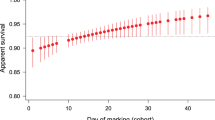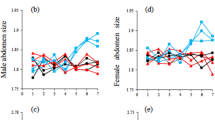Summary
In butterflies and many other insects there is a general tendency for males to emerge before females. This is known as protandry. In this paper we advance the hypothesis that protandry is a reproductive strategy of males, resulting from competition for mates, and should primarily occur in species maintaining female monogamy. Our hypothesis is corroborated by applying a mathematical treatment to a theoretical population with seven defined properties, all of which are argued to be reasonable assumptions for natural populations.
Similar content being viewed by others
References
Barth, R.H., Lester, L.J.: Neuro-hormonal control of sexual behavior in insects. Ann. Rev. Entomol. 18, 445–472 (1973)
Berge, S., Rebel, H.: Schmetterlingsbuch nach dem gegenwärtigen Stande der Lepidopterologie, pp. A55. Stuttgart: Schweizerbart 1910
Burns, J.M.: Mating frequency in natural populations of skippers and butterflies as determined by spermatophore-counts. Proc. Natl. Acad. Sci. USA 61, 852–859 (1968)
Danilevskii, A.S.: Photoperiodism and seasonal development in insects. Edinburgh-London: Oliver and Boyd 1965
David, W.A.L., Gardiner, B.O.C.: Oviposition and the hatching of eggs of Pieris brassicae (L.) in a laboratory culture. Bull. Entomol. Res. 53, 91–109 (1962)
Demoll, R.: Die Bedeutung der Proterandrie bei Insecten. Zool. Jahrb. Syst. 26, 621–628 (1908)
Douwes, P.: Size of, gain to and loss from a population of adult Heodes virgaureae L. (Lep., Lycaenidae). Entomol. Scand. 1, 263–281 (1970)
Economopoulos, A.P., Gordon, H.T.: Sperm replacement and depletion in the spermatheca of the S and CS strains of Oncopeltus fasciatus. Entomol. Exp. Appl. 15, 1–12 (1972)
Ford, E.B.: Butterflies, London: Collins 1945
Forster, W.: Biologie der Schmetterlinge, pp. 138–139. Stuttgart: Franck'sche Verlagshandlung 1954
Gilbert, L.E.: Postmating female odor in Heliconius butterflies: A male-contributed antiaphrodisiac? Science 193, 419–420 (1976)
Gossard, T.W., Jones, R.E.: The effects of age and weather on egg-laying in Pieris rapae L. J. Appl. Ecol. 14, 65–71 (1977)
Labine, P.A.: Population biology of the butterfly Euphydryas editha. I. Barriers to multiple inseminations. Evolution 18, 335–336 (1964)
Labine, P.A.: The population biology of the butterfly Euphydryas editha. IV. Sperm precedence—A preliminary report. Evolution 20, 580–586 (1966)
Labine, P.A.: The population biology of the butterfly Euphydryas editha. VIII. Oviposition and its relation to patterns of oviposition in other butterflies. Evolution 22, 799–805 (1968)
Larsen, T.B.: Butterflies of Lebanon, pp. 87. Faringdon: Classey 1974
LeFevre, G., Jr., Jonsson, U.B.: Sperm transfer, storage, displacement, and utilization in Drosophila melanogaster. Genetics 47, 1719–1736 (1962)
Lundgren, L., Bergström, G.: Wing scents and scent-released phases in the courtship behaviour of Lycaeides argyrognomon (Lepidoptera: Lycaenidae). J. Chem. Ecol. 1, 399–412 (1975)
Newman, L.H.: The complete British butterflies in colour, pp. 13. London: Ebury Press and Michael Joseph 1968
Parker, G.A.: Sperm competition and its evolutionary consequences in the insects. Biol. Rev. 45, 525–567 (1970)
Pease, R.W., Jr.: The evolutionary and biological significance of multiple pairing in Lepidoptera. J. Lepid. Soc. 22, 197–209 (1968)
Petersen, B.: Die geographische Variation einiger Fennoskandischer Lepidopteren. Zool. Bidrag Uppsala 25, 329–531 (1947)
Petersen, W.: Über die Ungleichzeitigkeit in der Erscheinung der Geschlechter bei Schmetterlingen. Zool. Jahrb. Syst. 6, 671–679 (1892)
Schlager, G.: Sperm precedence in the fertilization of eggs in Tribolium castaneum. Ann. Entomol. Soc. Am. 53, 557–560 (1960)
Scott, J.A.: Mating of butterflies. J. Res. Lepid. 11, 99–127 (1973 a)
Scott, J.A.: Convergence of population biology and adult behavior in two sympatric butterflies, Neominois ridingsii (Papilionoidea, Nymphalidae) and Amblyscirtes simius (Hesperoidea, Hesperidae). J. Anim. Ecol. 42, 663–672 (1973 b)
Scott, J.A.: Lifespan of butterflies. J. Res. Lepid. 12, 225–230 (1974a)
Scott, J.A.: The interaction of behavior, population biology, and environment in Hypaurotis crysalus (Lepidoptera). Am. Midl. Natur. 91, 383–394 (1974b)
Scott, J.A.: Adult behavior and population biology of Poladryas minuta, and the relationship of the Texas and Colorado populations (Lepidoptera, Nymphalidae). Pan-Pac. Entomol. 50, 9–22 (1974c)
Scott, J.A.: Movements of Precis coenia, a ‘pseudoterritorial’ submigrant (Lepidoptera, Nymphalidae). J. Anim. Ecol. 44, 843–850 (1975)
Shepard, J.H., Shepard, S.S.: Subfamily Parnassinae, pp. 403–409. In: The butterflies of North America (W.H. Howe, M. Coord, eds.). Garden City, New York: Doubleday 1975
Stern, V.M., Smith, R.F.: Factors affecting egg production and oviposition in populations of Colias philodice eurytheme Boisduval (Lepidoptera: Pieridae). Hilgardia 29, 411–454 (1960)
Swailes, G.E.: Reproductive behaviour and effects of the male accessory gland substance in the cabbage maggot, Hylemya brassicae. Ann. Entomol. Soc. Am. 64, 176–179 (1971)
Tauber, M.J., Tauber, C.A.: Insect seasonality: diapause maintenance, termination, and postdiapause development. Ann. Rev. Entomol. 21, 81–107 (1976)
Watt, W.B., Chew, F.S., Snyder, L.R.G., Watt, A.G., Rothschild, D.E.: Population structure of Pierid butterflies. I. Numbers and movements of some montane Colias species. Oecologia (Berl.) 27, 1–22 (1977)
Wiklund, C.: Courtship behaviour in relation to female monogamy in Leptidea sinapis L. (Lep., Pieridae). Oikos 29 (in press, 1977 a)
Wiklund, C.: Oviposition, feeding, and spatial separation of breeding and foraging habitats in a population of Leptidea sinapis L. (Lepidoptera). Oikos 28,56–68 (1977b)
Author information
Authors and Affiliations
Rights and permissions
About this article
Cite this article
Wiklund, C., Fagerström, T. Why do males emerge before females?. Oecologia 31, 153–158 (1977). https://doi.org/10.1007/BF00346917
Received:
Issue Date:
DOI: https://doi.org/10.1007/BF00346917




